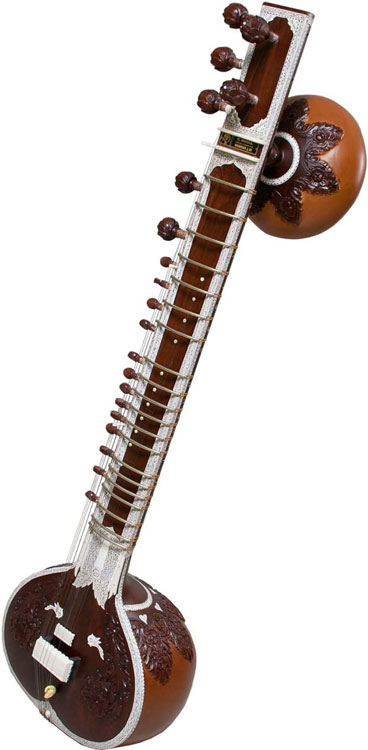The sitar, an Indian classical stringed instrument with a body made from a gourd base, features both sympathetic and melody strings. It is most commonly associated with Hindustani music, but it can also be found throughout South Asia, including in Pakistan, Afghanistan, Bangladesh, and Nepal. Moreover, the sitar is currently performed by musicians from the South Asian diaspora living in Europe (specially the UK), the United States, Canada and elsewhere; as well as musicians of other backgrounds who became interested in the sitar.
A sitar may have 18, 19, 20, or 21 strings, with 6 or 7 played strings running over curved and raised frets, and the remaining strings, known as tarb or taarif, serving as sympathetic strings and resonating with the played strings. These sympathetic strings are often used to establish the mood of a raga at the beginning of a performance. The movable frets, called pardā or thaat, allow for fine-tuning, while the played strings are attached to tuning pegs located at or near the head of the instrument. The sympathetic strings, which come in various lengths, pass through small holes in the fretboard and are connected to smaller tuning pegs located down the neck of the instrument.
The sitar has two bridges: the large bridge, also known as badaa goraa, which is used for the playing and drone strings, and the small bridge, or chota goraa, which is utilized for the sympathetic strings. The instrument’s unique timbre is created through the interplay between the strings and the wide, rounded bridge. As the string vibrates, its length changes slightly as it moves along the bridge’s rounded surface, producing overtones and imbuing the sound with its characteristic tone. The shaping of the bridge to maintain this tone is referred to as jawari, and many musicians rely on instrument makers to perform this task.
The construction of the sitar relies on various materials, including tun wood (a type of mahogany) or teak wood for the neck and faceplate, and calabash gourds to serve as resonating chambers. The bridges are fashioned from deer horn, ebony, or, on occasion, camel bone. Nowadays, synthetic materials are also commonly used.
In the late 1950s and early 1960s, Ravi Shankar, accompanied by Alla Rakha on tabla, further introduced Indian classical music to Western culture. The sitar gained popularity in Western pop music when George Harrison, influenced by David Crosby’s advocacy of Shankar, incorporated the instrument into Beatles tracks like “Norwegian Wood (This Bird Has Flown),” “Love You To,” and “Within You Without You” between 1965 and 1967.
The Beatles’ association with the sitar helped make Indian classical music more popular among Western youth, particularly once Harrison began studying with Shankar and his disciple, Shambhu Das, in 1966. In the same year, Brian Jones of the Rolling Stones played the sitar on “Paint It Black,” while English guitarist Dave Mason incorporated it into Traffic’s 1967 hits “Paper Sun” and “Hole in My Shoe.”
Shawn Phillips played the sitar on Donovan’s 1966 album “Sunshine Superman,” and on one song on Donovan’s subsequent album “Mellow Yellow,” produced in 1967. In the early 1970s, Spanish musician Gualberto brought the sitar into flamenco music, creating original flamenco-inspired pieces on the instrument.
Over the years, the sitar has been employed to produce a diverse assortment of musical fusions, encompassing everything from the amalgamation with Western and Persian classical music to the pioneering efforts of Transglobal Underground, Anoushka Shankar‘s collaborations with flamenco musicians, and Prem Joshua’s world fusion recordings.
(headline image: G. Rosul sitar)


